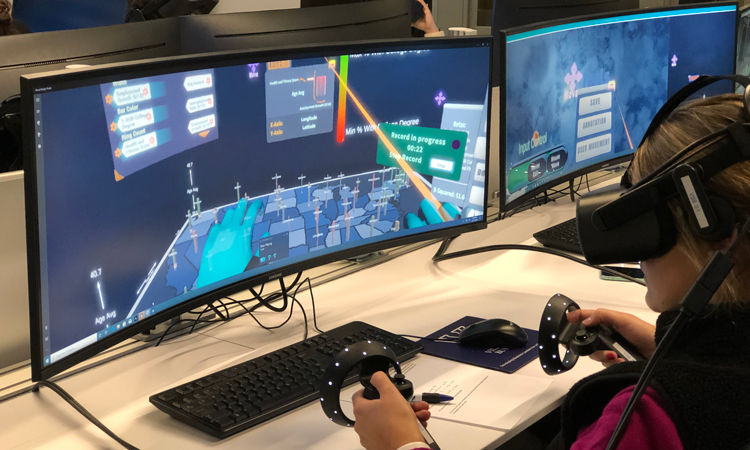A New World: How VR Technology is Changing the Way Students Interact with Data

Virtual Reality: what we may recognize as a gadget for gamers has found its way into the Villanova School of Business. However, this technology isn’t being used to play games—students are using it to interact with data. D6 VR is a virtual reality data modeling software that allows students to immerse themselves in world of data. Its implementation in VSB’s Victoria and Justin Gmelich ’90 Lab for Financial Markets during the 2019-2020 academic year has advanced the way students and faculty alike understand and analyze data.
Andy Maggio founded D6 VR after spending 15 years at Morgan Stanley as an investment analyst; recognizing the limits of working with two-dimensional spreadsheets to process data. The Virtual Reality company is revolutionizing the way businesses, and business students, interact with data. D6 VR was created with the goal to allow users to get more out of their data, faster. “It is a terrific tool for students as the importance of learning data analysis is increasing,” said Maggio. “Villanova is at the forefront of getting VR technology into students’ hands.”
Matthew Liberatore, PhD, John F. Connelly Endowed Chair in Management; Professor, Management & Operations, and Sue Metzger, Professor of the Practice, Information Systems, had the opportunity to incorporate this technology into their respective classes. In Dr. Liberatore’s data analytics module of Business Analytics, students worked in groups in the Gmelich Lab where the VR headsets—called Head Mounted Devices (HMD’s) are located. Once in the lab, students were tasked to forecast real estate prices, ultimately interacting with the data in a whole new reality.
“Students were able to visually identify outliers and develop forecasting models to predict real estate prices,” noted Dr. Liberatore. “This is a whole new approach to data analysis where students become engaged in the virtual space while working with the data set, much like playing a virtual reality game.”
In Dashboard Analytics, the MBA class taught by Professor Metzger, students explored large data sets and searched for correlations that would tell a story. “Because they had six dimensions to work with, they were able to highlight multi-dimensional relationships and commonalities between clusters of data,” Metzger said. She further noted, “Most students came back and were surprised by how much it helped them find the story they wanted to tell.” Exposure to this technology provides students with the skills that employers are looking to develop and allows them to understand these models in an increasingly impactful way.
After such positive experiences with this software, the professors hope to continue teaching it in the future. With the uncertainty of COVID-19, plans for the use of the VR technology in the coming semesters are uncertain. Regardless of where we find ourselves in the coming months, one thing is sure: virtual reality is here, and it’s revolutionizing the way students and businesses interact with data.
To learn more about D6 VR technology, check out the following videos:
D6 VR Virtual Workspace
